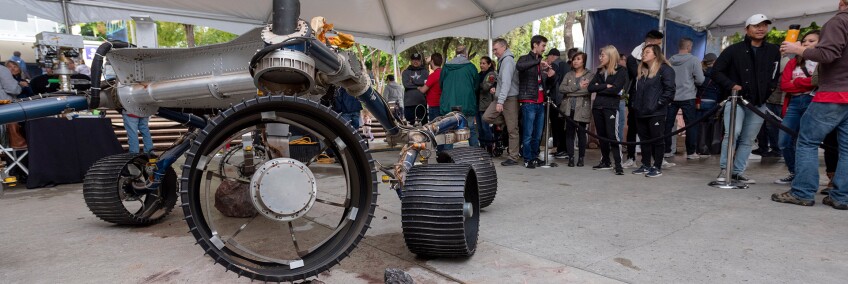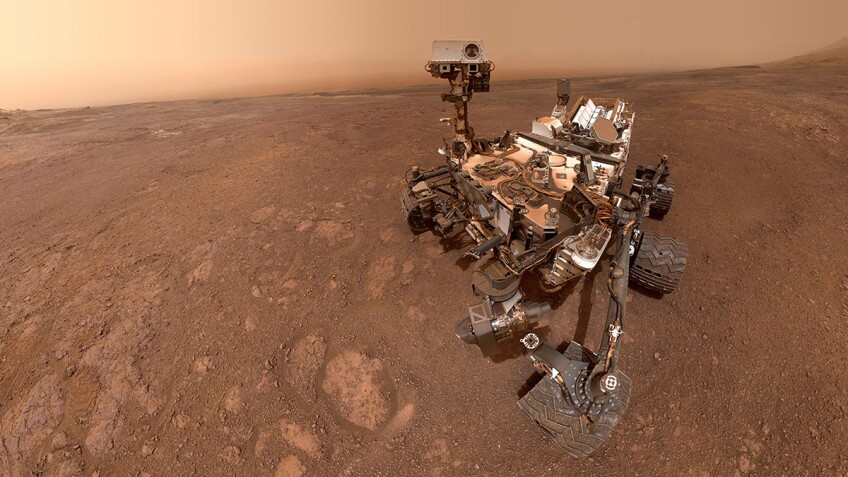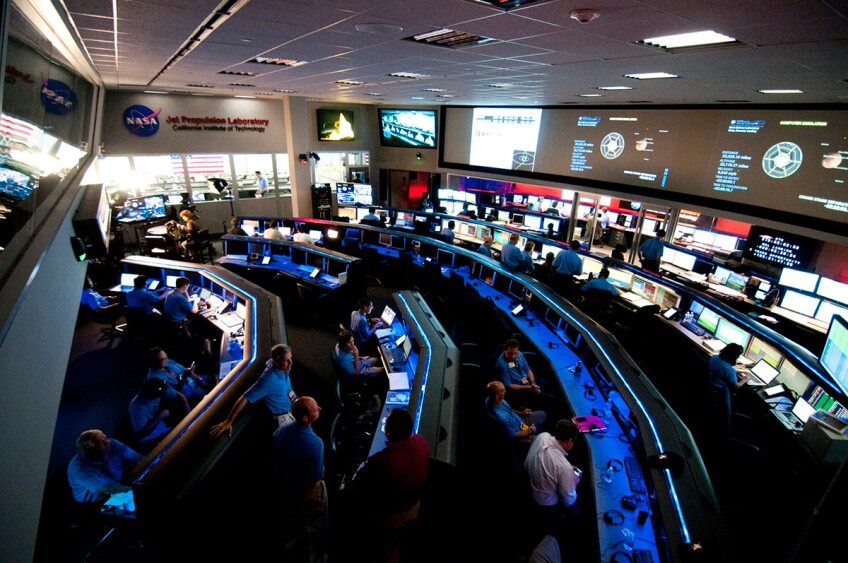Fun Facts about NASA's Jet Propulsion Laboratory


Relive the excitement of man’s first steps on the moon and the long journey it took to get there with 20 new hours of out of this world programming on KCET's “Summer of Space" Watch out for “American Experience: Chasing the Moon” and a KCET-exclusive first look at "Blue Sky Metropolis," four one-hour episodes that examine Southern California’s role in the history of aviation and aerospace.
An impressive and beautiful 177-acre campus in Pasadena, the Jet Propulsion Laboratory (JPL) is a federally-funded research and development facility overseen by Caltech for NASA. JPL specializes in robotic Earth and space missions. Notably, JPL built, sent and landed the four Mars rovers: Sojourner, Opportunity, Spirit and the still-active Curiosity rover. The next rover, the Mars 2020 rover, is currently being assembled at JPL. It's thanks to NASA'S Jet Propulsion Laboratory that the "Mars is the only known planet solely inhabited by robots" meme is actually true.
Because of the vastness of JPL's impact on Southern California — from its employment of some 6,000 people to the mind-blowing scientific feats accomplished by those JPL employees — it's hard not to be fascinated by this government facility, and the good news is that you can get a look behind the scenes.
Thanks to NASA's excellent outreach programs, it's not all top secret all the time at JPL. Through events open to the public and a huge variety of online resources, NASA has made JPL quite accessible and engaging. Here's what you need to know about NASA's Jet Propulsion Laboratory and how to get involved in what they’re currently up to.

What's in a Name?
Jet propulsion used to be the main subject of interest for JPL, but that is not the case anymore. Now, its missions include robotics, planetary exploration, Earth science projects, space-based astronomy and other experimental research. JPL is also responsible for the Deep Space Network, a worldwide array of antennas that allows NASA to keep in touch with its various spacecraft.
Location, Location … Technicality
While most outlets state that the Jet Propulsion Laboratory is in Pasadena, it is technically located in The City of La Cañada Flintridge. JPL's 91109 digits are a Pasadena zip code, and most people know where Pasadena is on the map, but JPL's own directions webpage includes both a Pasadena address as well as a La Cañada Flintridge location.
Home to the Center of the Universe

The Space Flight Operations Facility is the official name for the mission control room at the Jet Propulsion Laboratory. It is also the "nerve center" for NASA's Deep Space Network, so basically, the Space Flight Operations Facility is an impressive multitasker. Because of its integral role in a variety of groundbreaking missions, it's been dubbed the "Center of the Universe." The Space Flight Operations Facility is also a National Historic Landmark.
Protecting Mankind from Asteroids
JPL's Center for Near Earth Object Studies (CNEOS) keeps track of near Earth objects (NEOs), which are asteroids and comets that orbit the sun with paths that come within 30 million miles of Earth's orbit. JPL's Asteroid Watch even offers a downloadable to keep track of the next few close asteroid approaches. Information about missions to explore asteroids can also be found on the Asteroid Watch site. To learn more about NEOs and how NASA keeps Earth safe from potential impacts, check out NASA's Planetary Defense Coordination Office.
Reach for the Social Media Stars
If you don't live near enough JPL to schedule a visit, Twitter is a great way to keep up with what's going on both in mission control and on Mars.

In addition to the main NASA JPL Twitter handle, be sure to follow the Curiosity rover's official account — which even has a blue checkmark — for educational and often hilarious tweets straight from the Gale Crater on Mars and right to your feed. The team behind the spunky Curiosity account is led by witty Twitter expert and social media maven Veronica McGregor, who is also the creator of the #NASASocial initiative. We look forward to tweets from the Mars 2020 mission too, but for now, Curiosity is the roving, tweeting social media star we love to follow.
There are too many amazing individuals working at JPL to list, but a couple to start following ASAP are Dr. Moogega Stricker, a planetary protection engineer involved with the Mars 2020 mission, as well as Bobak Ferdowsi, a systems engineer who became an overnight sensation when his iconic star-themed hair dazzled those who watched the Curiosity landing in 2012. Both are excellent science communicators who make Twitter more fun, educational and — yes — out of this world.
For a full list of JPL's social media presences, check out this webpage.
Visit JPL in Person with Ticket to Explore
Once a year, JPL opens its doors to visitors for a free weekend-long event called Ticket to Explore. The event is so popular that its free tickets "sell out" quickly, so those who want to attend should be vigilant about securing their reservations. JPL announces ticket sales ahead of time, so it's easy to set a calendar alert.

During Ticket to Explore, visitors can watch life-sized rover demonstrations, peruse special galleries and experiences set up for the event and even enter buildings and watch scientists at work. At the 2019 Ticket to Explore event last May, visitors were able to enter the facility where the Mars 2020 rover is being built.
Each open house event features JPL employees available to talk to and to ask your most burning space-related questions. Getting to ask engineers in person about their work on projects that are changing our understanding of the solar system is quite a rewarding experience for children and adults alike.
In addition to Ticket to Explore, the Jet Propulsion Laboratory hosts other events open to the public, such as the Theodore von Kármán Lecture Series, smaller tours of the facility, workshops and other special events. To learn more about JPL's events, check out their Events Calendar.
The Next Best Thing to Traveling to Mars
If you weren't able to see the Mars 2020 rover in person, there's good news. You can look at it right now on JPL's Seeing 2020 livestream. To understand what you're looking at, here's some background information: Mars 2020 will be a car-sized rover launching in July or August 2020 with a landing date in Mars' Jezero Crater on February 18, 2021. When it lands, there will be a lot to look forward to.

Among other things, the Mars 2020 rover will be the first rover to drill for samples of the Red Planet's soil and rocks — samples that will potentially be retrieved and brought to Earth for further study. To witness this high-tech beast of science being put together is quite the privilege, but in case that isn't cool enough, JPL also hosts moderated chats along with the live stream Monday through Friday from 11:00 a.m. to 4:00 p.m. on YouTube.
More Ways to Mars It Up
The Mars 2020 rover needs an official name, and NASA and JPL are asking school-aged children to help choose the spacefaring robot's handle. The Name the Rover contest opens in August 2019 to K-12 students (enrolled or homeschooled) in the United States. Submissions include a suggestion for the rover's name and a short essay up to 150 words. If you don't qualify to submit a name but still want to be part of this fun initiative, you can sign up here to be a judge and — when the time comes — inevitably upvote 'Rover McRoverface.'

Still want more Mars 2020 in your life? We can't blame you. It's a pretty cool rover, and you can even put your mark on it. NASA and JPL invite you to sign up to send your name to Mars on the Mars 2020. Fill out your form here before Sept. 30!
For more fun and educational activities, JPL also provides a webpage full of cool ways to learn more JPL's robotic missions, research and more. Reach for the Mars!
Top Image: Ticketed guests at JPL's Ticket to Explore event in May 2019 take a look at robots under contruction. | Flickr/NASA Jet Propulsion Laboratory/Creative Commons (CC BY-NC-ND 2.0)


